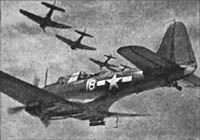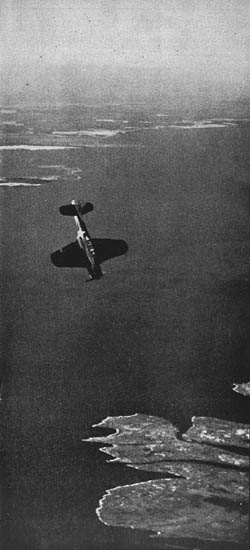The story of the SBD Dauntless dive bomber in the Pacific from Bureau of Naval Personnel Information Bulletin, (“All Hands Magazine”), September 1944.
Jap-hunting SBDs fly in formation over a carrier of Task Force 58 in the Pacific.
War Record of the SBD
Dauntless Divebomber, Giving Way to Harder-Hitting Successor, Was Spearhead of Our Attacks in the Pacific
The 5,936th and last of a distinguished strain of aircraft–the Navy’s SBD, which is giving way to a faster, long-range divebomber–rolled off the production line of the Douglas Aircraft Company’s plant at El Segundo, Calif., on 21 July.
Its completion closed a chapter in the history of naval aviation that will be discussed as long as men continue to talk about this war’s great battles in the Pacific.
On 7 Dec. 1941, when the Japanese attacked Pearl Harbor, a rear-seat gunner in an SBD knocked down a Zero that may have been the first Jap plane destroyed by U.S. aircraft. From then on the story of the SBD, or Douglas Dauntless divebomber, is closely interwoven with the successes of the fleet.
The enemy first felt the real sting of the SBD when Admiral William F. Halsey Jr., USN, took a small task force into the Gilbert and Marshall Islands in February 1942. Flying again from the deck of the USS Enterprise, as they had at Pearl Harbor, SBDs suddenly appeared over the atolls of those islands in the outer ring of the enemy’s defenses, dived to low altitude and dropped their 1,000-pound bombs on ships, hangars, airstrips and buildings.
The following month this same force staged a repeat performance for the benefit of the Japs on Marcus and Wake Islands.
Meanwhile every flyable Dauntless had been mustered for fleet duty. New pilots assigned to the fleet waited restlessly at naval air stations in the States for their advanced training in SBDs they would soon take into combat. Finally a squadron returning from combat flew 18 well-worn SBDs into San Diego. The impatient new pilots thought at last their time had come to get ready far the big show.
But several weeks later a carrier heading for the Pacific picked up the 18 planes. Again there were no Dauntlesses for advanced training.
SBDs on their way to blast Palau. Official U. S. Navy photograph.
By March the first of a new batch of Dauntlesses were coming off the line. Once again the training proceeded. A squadron was ready to go within a month after it received its full complement of planes. Soon thereafter the SBD-3 was on its way to the war zone–the first replacement bombers the Navy had had since the start of the war.
The first large fleet engagement, the Battle of the Coral Sea, found the SBDs giving the Jap a real taste of their wallop. One enemy carrier went down and several other ships were seriously crippled by the divebombers.
A mass of wrecked shipping in Tulagi Harbor testified to the surprise visit paid by SBDs from the old USS Yorktown. It was there the Japanese pilots learned that even their snappy Zero fighters were not safe in a dogfight with the SBD.
Then came Midway, the most destructive sea-air fight in history and the SBD’s own great triumph. At least four enemy carriers sank as a result of the deadly-accurate divebombing by Dauntless squadrons from the Enterprise, Hornet and Yorktown.
When the fleet returned to Pearl Harbor after this battle, the area around the repair hangars gave ample evidence of why the SBD was known as “the pilot’s friend.” Many Dauntlesses returned from Midway with gaping wounds in their wings, fuselages and tail surfaces. Wondering pilots who had been there found it incredible that an airplane could absorb so much punishment and still manage to return to its carrier.
Diving SBD screams down on its target at 290 knots and an angle of 75 degrees. Official U.S. Navy photograph.
The Dauntless spearheaded the air assault on Guadalcanal in support of Marine landings. Its greatest ordeal and triumph came in the fall of 1942, when it took to the beach and operated as a shore-based bomber off Henderson Field on Guadalcanal. With a handful of SBDs Navy and Marine pilots patrolled the long stretches to the northwest, morning, afternoon and night, to spot the “Tokyo Express,” the enemy’s fast-moving cruiser and destroyer forces, which made almost daily visits to the island from their base on Bougainville.
With routine-like precision, the SBDs would take off from Henderson Field early in the afternoon, usually in a group of a dozen or less, and bomb the Express on its way to Guadalcanal. During the night smaller groups attacked the ships to harass their unloading operations. Just before dawn, the dozen planes would take off and bomb the Japs again on their way home.
As Admiral Halsey’s drive up the Solomons chain got underway, the Dauntless helped to pave the way. When a pinpoint objective had to be hit, the SBD took the assignment. When the increasingly rare Jap shipping came within range, it was the Dauntless that went out to stop it. As the new airfields fell to the advancing Marines, Dauntlesses would be among the first to land and operate.
By the summer of 1943, the long-dormant carrier war had sprung up anew. More and more of the big U.S. carriers were completed and joined the mounting offensive in the Central Pacific. Now the SBD was pounding a retreating instead of an advancing foe. From the first small carrier strike at Marcus Island through the Marianas invasion, the Dauntless was pasting the enemy’s bases. Wake, the Gilberts, the Marshalls, Truk, Rabaul, Palau, Hollandia–all felt its bombs. It was one of the principal weapons in the arsenal of Task Force 58.
Although the glory now began to be shared with newer and faster planes, the SBD maintained the lowest ratio of losses per mission of any plane operating in the theater.
Backing up praise of the “pilot’s friend” are the statistics of the Dauntless performance. From Pearl Harbor to April 1944, SBDs flew 1,189,473.9 operational hours. Twenty-five per cent of all operational hours flown off aircraft carriers were flown by the SBD. That includes the scores of small carriers which did not carry it. Marine SBDs have flown 26% of all Marine operational hours.
During the seven months from the Battle of the Coral Sea to the last big Jap strike on Guadalcanal in November 1942–the period of the great holding battle in the Pacific–SBDs sank 4 aircraft carriers, 14 cruisers, destroyers, 15 transports or cargo ships and scores of lesser craft.
In addition, in collaboration with torpedo planes, surface gunfire and submarines, they destroyed two more carriers and one patrol ship and inflicted damage on 3 carriers, 5 patrol ships, 11 cruisers and 5 transport or cargo ships.













I don’t care what anyone says, SBD was a fine plane.